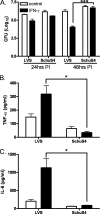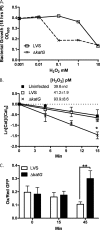Francisella tularensis antioxidants harness reactive oxygen species to restrict macrophage signaling and cytokine production
- PMID: 20558723
- PMCID: PMC2934622
- DOI: 10.1074/jbc.M110.144394
Francisella tularensis antioxidants harness reactive oxygen species to restrict macrophage signaling and cytokine production
Abstract
Francisella tularensis is the etiologic agent of the highly infectious animal and human disease tularemia. Its extreme infectivity and virulence are associated with its ability to evade immune detection, which we now link to its robust reactive oxygen species-scavenging capacity. Infection of primary human monocyte-derived macrophages with virulent F. tularensis SchuS4 prevented proinflammatory cytokine production in the presence or absence of IFN-gamma compared with infection with the attenuated live vaccine strain. SchuS4 infection also blocked signals required for macrophage cytokine production, including Akt phosphorylation, IkappaB alpha degradation, and NF-kappaB nuclear localization and activation. Concomitant with SchuS4-mediated suppression of Akt phosphorylation was an increase in the levels of the Akt antagonist PTEN. Moreover, SchuS4 prevented the H(2)O(2)-dependent oxidative inactivation of PTEN compared with a virulent live vaccine strain. Mutation of catalase (katG) sensitized F. tularensis to H(2)O(2) and enhanced PTEN oxidation, Akt phosphorylation, NF-kappaB activation, and inflammatory cytokine production. Together, these findings suggest a novel role for bacterial antioxidants in restricting macrophage activation through their ability to preserve phosphatases that temper kinase signaling and proinflammatory cytokine production.
Figures





References
-
- Oyston P. C., Sjostedt A., Titball R. W. (2004) Nat. Rev. Microbiol. 2, 967–978 - PubMed
-
- Telepnev M., Golovliov I., Sjöstedt A. (2005) Microb. Pathog. 38, 239–247 - PubMed
-
- Rajaram M. V., Ganesan L. P., Parsa K. V., Butchar J. P., Gunn J. S., Tridandapani S. (2006) J. Immunol. 177, 6317–6324 - PubMed
Publication types
MeSH terms
Substances
Grants and funding
LinkOut - more resources
Full Text Sources
Research Materials

